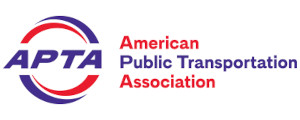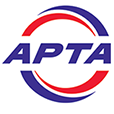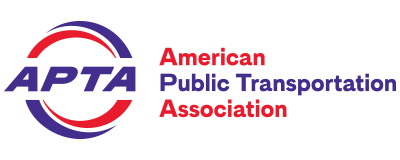Washington, D.C. (July 14, 2025) – The American Public Transportation Association (APTA) today recognized the outstanding sustainability achievements of two of its member organizations – Dallas Area Rapid Transit (DART) and Pierce Transit – by awarding them with Gold and Silver recognition, respectively, in the APTA Sustainability Commitment program.
The APTA Sustainability Commitment program is a voluntary initiative where public transit agencies and businesses pledge to implement practices that continuously advance environmental, social, and economic sustainability goals. Based on measurable achievements, organizations receive recognition at Platinum, Gold, Silver, or Bronze levels. Since its inception in 2009, 140 public transit agencies and businesses have signed on, with 51 signatories having reached higher-level recognition.
“APTA is proud to honor DART and Pierce Transit for their dedication to building a more sustainable future,” said APTA President and CEO Paul P. Skoutelas. “DART’s Gold recognition and Pierce Transit’s Silver recognition reflect not only strong leadership but also measurable progress in reducing environmental impact and enhancing quality of life for the communities they serve. Their accomplishments help set the standard for what’s possible in sustainable public transportation.”
Gold Level – Dallas Area Rapid Transit (DART)
Dallas Area Rapid Transit (DART) is advancing sustainability through strategic infrastructure upgrades and a long-standing commitment to clean energy. In 2021, DART completed an Investment Grade Audit (IGA) Report that laid the foundation for a more energy-efficient and environmentally responsible public transit system. Guided by the IGA, DART implemented comprehensive energy-saving measures, including the installation of LED lighting across all buildings, rail station facilities, and parking areas. These upgrades were further enhanced with occupancy sensors and motion detectors, significantly reducing energy use—by as much as 40 percent in parking lots and garages.
In 2022, DART took a major step toward climate responsibility by securing a new electricity contract sourced entirely from renewable energy. Within two years, DART transitioned to 100 percent renewable electricity for all facilities and light rail operations, reinforcing its leadership in sustainable public transit.
DART’s environmental commitment extends to its bus fleet, which has operated on compressed renewable natural gas (CNG-RNG) for nearly a decade. By using 100 percent renewable CNG, DART buses produce 75 percent fewer emissions than gasoline or diesel-powered vehicles, contributing to cleaner air and a reduced carbon footprint across the North Texas region.
Silver Level – Pierce Transit
Since piloting its first compressed natural gas (CNG) buses in 1986, Pierce Transit has kept sustainability at the forefront of how it serves and engages with its community. The agency has reduced its total emissions by 19 percent (adjusted for service levels) since 2017. In 2018, Pierce Transit’s CEO issued Executive Order No. 1, committing to the use of green technologies and strategies. The agency’s 2024–2028 Strategic Plan prioritizes sustainability across its finances, infrastructure, and environmental practices.
In 2022, Pierce Transit signed on to the FTA’s Sustainable Transit for a Healthy Planet Challenge and has since developed a Zero Emission Bus Transition Strategy and Green Fleet Strategic Objective to achieve 100 percent electrification of its revenue fleet by 2042. The agency’s Zero Emissions Coordinator collaborates with Maintenance, Finance, and Operations departments to explore new technologies and reduce the agency’s carbon footprint—efforts that include transitioning its diesel fleet to 100 percent renewable R99 diesel and its CNG fleet to RNG in 2023.
Pierce Transit’s commitment to sustainability extends beyond fleet operations. Initiatives include recycling fluids and materials, coordinating employee transportation benefit programs with local businesses, opening a new fueling and bus wash facility that reduces wastewater by 90 percent, and installing energy-efficient lighting at its base and regional transit hubs.
###



